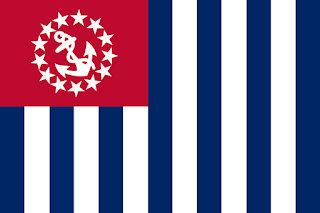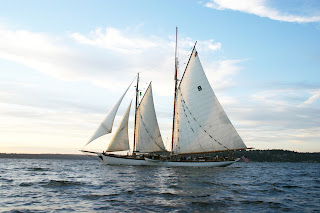Vexillology is the study of flags. There are different rules for different countries. These rules have been established over hundreds of years. This post distills vexillology as it applies to U.S. pleasure boats (and mainly sail boats).
Some terminology: vessels wear flags, people fly flags. Flags have two dimensions, called the fly (width) and the hoist (height). The hoist is also the point closest to the flagpole, and the fly the point furthest away from the flagpole.
What Flags Can I Fly?
-
U.S. Ensign

The U.S. Ensign The U.S. Ensign, commonly called the U.S. Flag, has the highest precedence. It is placed in the most important location on the boat. The design of the ensign is laid out in Title 4 of the U.S. Code Chapter 1.
Most U.S. Ensigns have the wrong proportions, because the hoist to fly 10:19 ratio in the code causes the flags to wear out faster than a more commonly available 2:3 or 3:5 ratio. Finding 10:19 ratio U.S. Ensigns is difficult. This calculator will give you the correct other dimensions, if one is specified.
The size of the ensign is based on the size of the boat, with the fly sized at one inch per foot LOA (length overall) of the boat, rounded up to the next commercially available size. Thus a Catalina 22 should have an ensign with a 22" fly, and 24" fly ensigns are available (although not with a 10:19 ratio—opportunity for someone). Other flags on the boat should be 1/2" for each foot of the tallest mast over the water line (30' to 15" for the Catalina 22), or 5/8" per foot LOA for power boats. A flag pole should generally be at least twice the hoist of the ensign.
-
U.S. Yacht Ensign
The U.S. Yacht Ensign is worn interchangeable with the U.S. Ensign while sailing in U.S. waters. One or the other should be worn, but not both. It has no meaning outside of U.S. national waters, so if traveling internationally must be replaced by the U.S. Ensign.

U.S. Yacht Ensign The U.S. Yacht ensign originally meant that the vessel was traveling from U.S. port to U.S. port and did not need to clear customs. Carrying goods that required U.S. customs while wearing this flag was considered smuggling. Since pleasure yachts typically did not have goods to declare, they also started wearing this flag. The flag has a 2:3 ratio.
-
State Flag
The State Flag is optional, but if worn, it has lower precedence than the U.S. Ensign. Some states, such as Washington, have codes on wearing flags on vessels.

Washington State Flag The Washington State flag has a 5:8 ratio, but other states may have other ratios.
-
Courtesy Ensign
When visiting another country, the civil ensign of the other country is displayed, generally on the starboard spreader. The civil ensign may not be the same as the national ensign of a country.

The Canadian Civil Ensign -
Yacht Club Burgee
A yacht club burgee can be worn at a bow staff, but is generally flown from the starboard spreader on a sail boat. If the state flag is worn on the spreader, it can be flown below the state flag or moved to the port spreader. It generally has the form of a pennant.

Edmonds Yacht Club Burgee -
Organizational Ensign
Organizational ensigns are from groups such as the United States Power Squadrons or Coast Guard Auxiliary.

The U.S. Power Squadrons Ensign. -
Private Signal
A private signal is a flag that identifies a person on board. It generally has a swallow tail.

Examples of Private Signals
Other Flags
There are other flags that are worn on occasion. The quarantine flag on entering a new country, regatta flags, man overboard flag, owner absent flag, etc.
Where Do I Fly Them?
There are six places that you can fly a flag (shown below in descending order of precedence). The rules that apply on land, where the U.S. Ensign is placed physically higher than other flags, do not apply to marine vessels. Flags should be placed at the place of highest precedence to which they are entitled to be worn. For example, a burgee or private signal is never flown at the stern. On the other hand, if a courtesy flag is worn on the starboard spreader, the burgee could be moved to the port spreader.
-
Gaff
The gaff is the pole that comes off the mast on gaff rigged boats. Unless you have some very unusual rigging, this doesn't apply to most sloops or power boats. However, to simulate this location, a flag may also be worn no more than 2/3rd of the way up the back stay on a sail boat.

Flag at the Gaff.
(Modified from a photo by Susan Davis CC BY-SA 3.0) -
Flagstaff on Stern
This is a pole attached to the stern of the boat. It can be centered, or offset, usually to the starboard, if necessary.
The Schooner Zodiac with U.S. Ensign Worn on Stern -
Bow Staff
This is a pole attached the the bow of the boat. On most sail boats this would interfere with the foresails, so this mostly applies to power boats.

Flag on Bow Staff
-
Starboard Yardarm or Spreader
If there is more than one spreader on a side, then it is flown from the lowest one. There may be more than one halyard on the spreader, in which case the outermost one has higher precedence.
-
Port Yardarm or Spreader
-
Masthead
The truck of the mast is the top (technically the ball at the top of the mast). If there are more than one mast, it is flown from the forward mast. On many sailing vessels, wearing a flag here interferes with sails, antennas, and anchor lights, but a pig stick can be used when at anchor.
When and How Are Flags Flown?
The U.S. Ensign or U.S. Yacht Ensign is typically raised at 8 a.m. or when the boat is first boarded. It is lowered at sunset. If other flags are raised or lowered at the same time, the U.S Ensign is raised first and lowered last. The U.S. Ensign should be raised quickly and lowered ceremoniously. If you are leaving a vessel, and do not expect to return before sunset, then the Ensign should be lowered before you leave.
State flags and courtesy flags are generally raised and lowered at the same time as the U.S. ensign. Yacht club burgees are generally worn day and night. Personal signals may also be worn day and night, however, they should not be worn when the person is not on board.
Additional References
If you are starting out, a good place to start is this page from the U.S. Power Squadron. They also offer a 37 page booklet ($15 including shipping) that is a great reference on flags on boats.
Another great resource is Reeds Maritime Flag Handbook by Miranda Delmar-Morgan.




